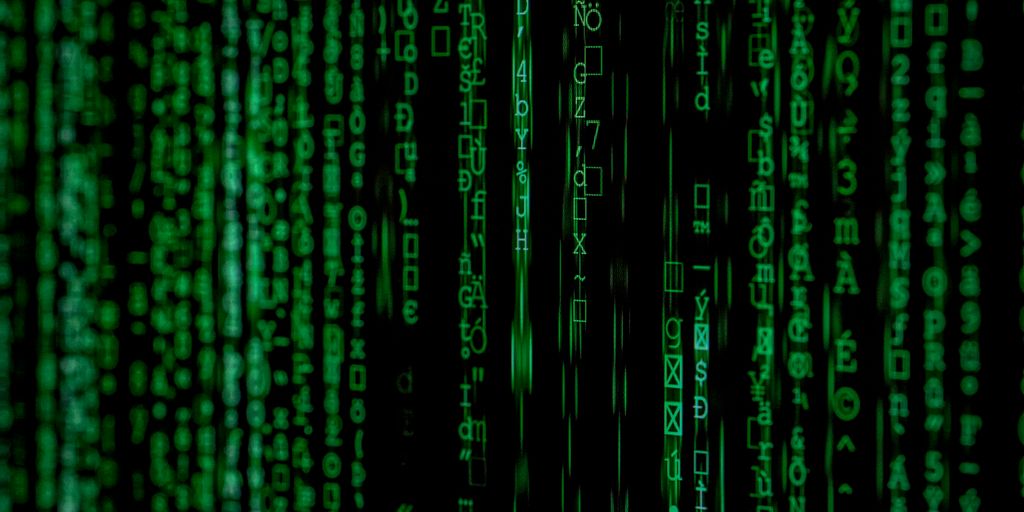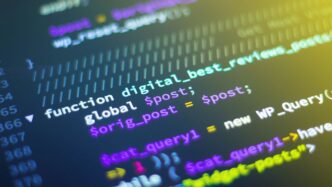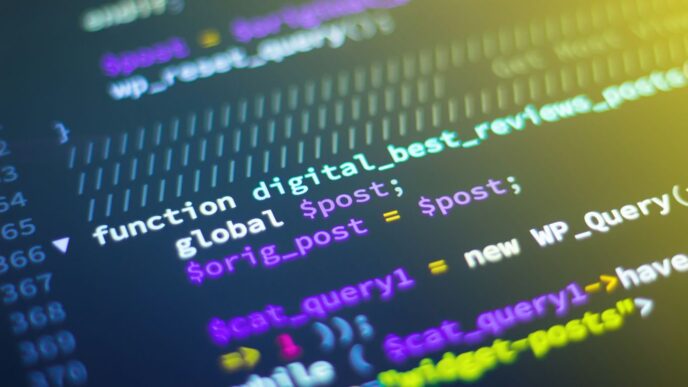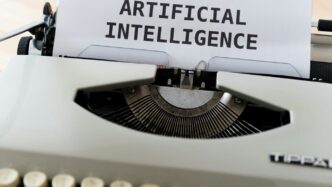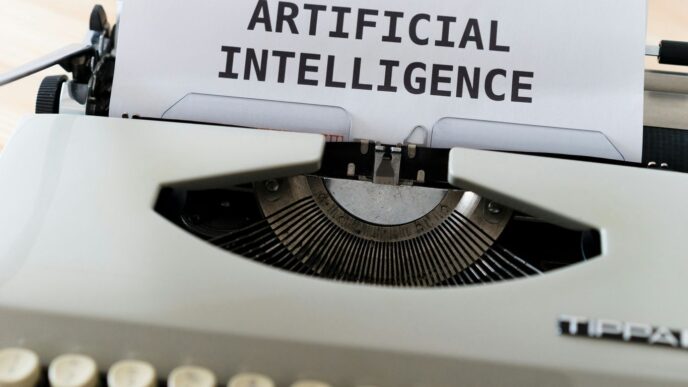Protecting the data used to train AI models is a big deal these days. As AI becomes more common, making sure that training data is safe and sound is super important. It’s not just about keeping secrets; it’s about making sure the AI works right and doesn’t do anything weird. We’ll go over some good ways to keep that training data protected.
Key Takeaways
- Always keep your training data safe; it’s the foundation of your AI.
- Think about rules like GDPR and CCPA when handling data.
- Make sure only the right people can get to your data.
- Use encryption to scramble data so no one else can read it.
- Watch out for anything unusual happening with your data or AI.
1. General Data Protection Regulation
When we talk about protecting data in AI, the General Data Protection Regulation, or GDPR, is a big deal. It’s a set of rules from the European Union that tells organizations how they need to handle personal data. Basically, if you’re dealing with data from anyone in the EU, you’ve got to follow these rules. The GDPR makes sure people have control over their personal information and how it’s used. This means companies can’t just collect whatever they want and do whatever they please with it. They have to be upfront about what they’re collecting, why they’re collecting it, and get permission from the person whose data it is. For AI, this is super important because AI models often gobble up huge amounts of data for training. If that data includes personal info, then GDPR applies. You need to make sure you have a legal reason to process that data for your AI, and you need to be clear about how your AI is going to use it.
Bias and Discrimination
One of the trickier parts of using data for AI, especially with GDPR in mind, is making sure your training data doesn’t lead to unfair outcomes. We’re talking about things like an AI model accidentally discriminating against certain groups of people based on their gender, race, or age. It’s a real concern, and it happens if the data you feed the AI isn’t balanced or representative. To avoid this, you really need to keep an eye on what your AI is producing. Regular checks of the AI’s outputs can help you spot if it’s acting in a way that’s not fair or ethical. It’s like having a quality control step, but for fairness. If you find issues, you need to adjust your data or your model to fix them. This is a continuous process, not a one-and-done thing.
Transparency
Another key aspect, especially with regulations like GDPR, is transparency. People want to know how AI systems arrive at their decisions. It’s not enough for an AI to just spit out an answer; you need to be able to explain how it got that answer. This means your AI systems shouldn’t be black boxes. You should be able to trace the decision-making process and understand why a particular outcome occurred. This is important for accountability and trust. If someone asks why your AI made a certain decision about their data, you should have a clear, understandable explanation ready. This often involves:
- Documenting the data sources used for training.
- Explaining the algorithms and models employed.
- Providing clear reasons for specific AI outputs.
- Having a process for individuals to challenge AI decisions.
- Regularly auditing the AI’s decision-making logic.
This level of openness helps build confidence in AI systems and shows that you’re taking data protection seriously. It’s all about making sure that even complex AI processes are understandable and accountable, especially when personal data is involved. For companies looking to make a positive impact, understanding AI for social good is a good start.
2. California Consumer Privacy Act
The California Consumer Privacy Act, or CCPA, is a big deal for anyone handling personal data, especially if you’re dealing with folks in California. It’s kind of like the GDPR’s cousin, but for the Golden State. This law gives consumers a lot more say over their personal information, which means businesses have to be super careful about how they collect, use, and share data. For AI, this means you can’t just grab any data and throw it into your models; you’ve got to make sure you’re playing by the rules. It’s all about transparency and giving people control. If you’re training AI models with data from California residents, you absolutely need to understand the CCPA inside and out.
2.1. Consumer Rights
The CCPA lays out several key rights for consumers, and businesses need to be ready to honor them. It’s not just about telling people what you’re doing; it’s about giving them the power to act. Here’s a quick rundown:
- Right to Know: Consumers can ask what personal information you’ve collected about them, where you got it from, why you’re collecting it, and who you’re sharing it with. You have to provide this information in a clear and understandable way.
- Right to Delete: If a consumer wants their data gone, you generally have to delete it. This can be tricky with AI models, as removing data might impact model performance, but it’s a requirement.
- Right to Opt-Out: Consumers can tell you not to sell their personal information. This is a big one, especially with targeted advertising and, increasingly, with data used for AI training. California’s data privacy protections are always evolving, so staying current on these opt-out provisions is key.
- Right to Non-Discrimination: You can’t treat consumers differently if they exercise their CCPA rights. So, no charging more or providing a lower quality of service just because someone opted out of data selling.
2.2. Business Obligations
Complying with the CCPA isn’t a one-and-done thing; it requires ongoing effort and a clear understanding of your responsibilities. Here are some of the main things businesses need to do:
- Provide Clear Privacy Notices: You need to tell consumers, in plain language, what data you collect, why you collect it, and their rights under the CCPA. This notice should be easy to find on your website.
- Implement Data Access and Deletion Mechanisms: You have to set up ways for consumers to submit requests to know or delete their data. This often involves a toll-free number and a web form.
- Verify Consumer Requests: Before you hand over or delete data, you need to make sure the person making the request is actually who they say they are. This prevents unauthorized access to personal information.
- Maintain Records: You’re required to keep records of CCPA requests and how you responded to them. This helps demonstrate your compliance if regulators come knocking.
- Update Privacy Practices Regularly: The CCPA, like many privacy laws, can change. You need to stay on top of any amendments or new guidance from regulatory bodies and adjust your practices accordingly.
3. Authentication

Authentication is a big deal when we’re talking about keeping AI training data safe. It’s basically making sure that only the right people, or systems, can get their hands on that data. Think of it like a bouncer at a club, but for your data. If someone tries to access your sensitive information without proper authentication, it’s like trying to get into that club without an ID – they’re not getting in. This is super important because AI models often train on really sensitive stuff, like personal health records or financial details. If that data falls into the wrong hands, it’s a huge problem. Strong authentication methods are a must-have to prevent unauthorized access to your valuable AI training datasets.
3.1 Multi-Factor Authentication (MFA)
So, what’s the best way to do this? Multi-Factor Authentication, or MFA, is a really good start. It’s not just about a password anymore. MFA means you need at least two different ways to prove you are who you say you are. It could be something you know (like a password), something you have (like a phone or a security token), or even something you are (like a fingerprint or face scan). This makes it way harder for bad actors to get in, even if they manage to steal a password. Imagine someone trying to break into your house, but they need your key and your fingerprint to get through the front door. It’s a much tougher challenge for them. For AI, this means protecting access to data repositories, model training environments, and even the AI models themselves. Implementing MFA across all access points for your AI data is a smart move.
3.2 Single Sign-On (SSO)
Then there’s Single Sign-On, or SSO. This might sound a bit counter-intuitive after talking about MFA, but it’s actually about making things easier for legitimate users while still keeping things secure. With SSO, you log in once, and then you can access multiple different systems or applications without having to log in again for each one. It’s like having one master key that opens several doors. For AI development teams, this can really streamline workflows. Instead of remembering a dozen different passwords for different data sources or tools, they just need one. But here’s the catch: that one login needs to be super secure, which is where MFA comes back into play. So, you combine the convenience of SSO with the security of MFA. It’s a win-win for productivity and data protection. This approach helps manage access to various components of the AI pipeline, from data ingestion to model deployment, all under a unified, secure authentication framework. For example, in AI-powered diagnostics, secure SSO would be critical for medical professionals accessing patient data for model training.
3.3 Biometric Authentication
Finally, let’s talk about biometric authentication. This is where you use unique physical or behavioral characteristics to verify identity. We’re talking fingerprints, facial recognition, iris scans, even voice recognition. It’s pretty sci-fi, but it’s becoming more and more common. The big advantage here is that biometrics are really hard to fake or steal. You can’t just guess someone’s fingerprint like you can guess a password. For highly sensitive AI training data, especially in fields like healthcare or finance, biometric authentication can provide an extremely high level of security. It adds another layer of trust, making sure that the person accessing the data is truly who they claim to be. Of course, there are privacy considerations with biometrics, so it’s important to implement these systems carefully and ethically. But for safeguarding critical AI assets, it’s a powerful tool in the security arsenal.
4. Encryption
Encryption is a big deal when it comes to protecting your AI training data. Think of it like putting your sensitive information in a super-secure vault, and only those with the right key can open it. This isn’t just about keeping nosy people out; it’s about making sure that even if someone somehow gets their hands on your data, it’s just a jumbled mess they can’t use. It’s a fundamental layer of defense, making data unreadable to anyone without authorization.
4.1. Data at Rest
"Data at rest" basically means data that’s stored somewhere, like on a hard drive, in a database, or in cloud storage. It’s not moving around. Encrypting this kind of data is super important because it protects against physical theft or unauthorized access to your storage systems. Imagine someone walks into your server room and just takes a hard drive. If that data isn’t encrypted, they’ve got everything. But if it is, they’ve just got a useless piece of metal. For AI training, this means all your datasets, model parameters, and any intermediate files should be encrypted when they’re not actively being used. This applies whether you’re storing it on your own servers or using a cloud provider. You need to make sure your cloud provider offers strong data encryption features.
4.2. Data in Transit
"Data in transit" refers to data that’s moving from one place to another. This could be data being uploaded to a cloud server, transferred between different systems within your network, or even just moving from your computer to a storage device. This is a vulnerable point because data can be intercepted during transfer. Think of it like sending a postcard versus sending a sealed letter. An unencrypted transfer is like a postcard – anyone can read it. Encrypted data in transit is like that sealed letter, making it much harder for snoopers to see what’s inside. For AI, this means securing the connections when you’re:
- Uploading new datasets to your training environment.
- Downloading model outputs or logs.
- Communicating between different components of your AI pipeline.
Using protocols like TLS (Transport Layer Security) for network communication is a common way to achieve this. It scrambles the data as it travels, and then unscrambles it at the destination.
4.3. Homomorphic Encryption
Now, this one’s a bit more advanced, but it’s really cool. Homomorphic encryption lets you perform computations on encrypted data without ever decrypting it. Seriously! Imagine you have a bunch of numbers, and you want to add them up, but you don’t want anyone to see the individual numbers or the final sum. With homomorphic encryption, you can add the encrypted numbers, and the result is still encrypted, but it’s the encrypted version of the correct sum. This is a game-changer for privacy in AI, especially when dealing with sensitive training data. It means you could potentially train a model on data that remains encrypted throughout the entire process, significantly reducing the risk of exposure. It’s still a developing field, but it holds a lot of promise for future AI security. It’s a way to maintain data trust even when processing sensitive information.
5. Access Controls
So, you’ve got all this sensitive data for training your AI models, right? Well, it’s not enough to just have it; you also need to make sure only the right people can get to it. Think of it like a really important vault – you wouldn’t just leave the door open for anyone to walk in. That’s where access controls come in. They’re basically the bouncers for your data, making sure only authorized users and systems can interact with your training datasets. Proper access controls are a must-have for keeping your AI training data safe from prying eyes and unauthorized changes. It’s all about setting up clear rules about who can do what with your data.
5.1 Role-Based Access Control (RBAC)
RBAC is a pretty common way to handle access. Instead of giving individual permissions to every single person, you group users by their job roles. So, if someone is a "data scientist," they get a certain set of permissions. If they’re a "project manager," they get another. It makes managing permissions a lot simpler, especially in bigger teams. You define roles, assign permissions to those roles, and then assign users to the roles. It’s a neat, organized system.
Here’s a simple breakdown of how RBAC might look for AI training data:
- Data Scientists: Can read, write, and modify specific training datasets. They might also have permissions to run training jobs.
- Data Annotators: Can only read and modify specific subsets of data for labeling purposes. They shouldn’t be able to delete entire datasets.
- Auditors: Can only read data access logs and dataset metadata. They can’t actually touch the data itself.
- System Administrators: Have broad access for system maintenance and troubleshooting, but their access to sensitive data should still be logged and monitored.
This way, you’re not constantly trying to figure out what each person needs individually. You just assign them a role, and boom, they have the right access.
5.2 Least Privilege Principle
This one is super important. The idea behind the least privilege principle is simple: give users only the minimum amount of access they need to do their job, and nothing more. If a data annotator only needs to read and label data, they shouldn’t have permission to delete entire datasets. It’s like giving someone a key to just one room when they only need to be in that one room, instead of giving them a master key to the whole building. This significantly reduces the risk of accidental data breaches or malicious activity. Even if an account gets compromised, the damage is limited because that account didn’t have excessive permissions to begin with. It’s a core security concept that applies really well to AI training data.
5.3 Regular Access Reviews
Access isn’t a one-and-done thing. People change roles, leave the company, or their responsibilities shift. That’s why you need to regularly review who has access to what. If someone moves from being a data scientist to a project manager, their old data scientist permissions should be revoked. If someone leaves, their access should be immediately terminated. It’s easy for permissions to pile up over time, creating security holes. Regular reviews, maybe quarterly or even more often for highly sensitive data, help you catch and fix these issues. It’s a bit of a chore, but it’s totally worth it for keeping your data secure. You can even automate some of these reviews to make it less painful. For more on how AI can help with security, check out this article on AI in cybersecurity.
5.4 Logging and Monitoring Access
Even with the best access controls, you still need to know what’s happening. Logging and monitoring data access is like having a security camera system for your data. Every time someone accesses, modifies, or tries to access your training data, it should be recorded. This log should include who did what, when they did it, and from where. Then, you need to actually look at these logs. Automated tools can help flag unusual activity, like someone trying to access data they normally wouldn’t, or a sudden spike in data downloads. This helps you detect unauthorized activities and potential security threats quickly. It’s not just about preventing; it’s also about detecting and responding. If something goes wrong, these logs are your best friend for figuring out what happened.
6. Adversarial Defenses
AI models, for all their smarts, aren’t perfect. They can be tricked, and that’s where adversarial defenses come in. Think of it like building a stronger immune system for your AI. Attackers try to mess with the data, either during training or when the model is actually being used, to make it do something wrong. This could be anything from misclassifying an image to revealing private information. Protecting against these sneaky attacks is super important for keeping AI systems reliable and secure.
6.1. Understanding Adversarial Attacks
Adversarial attacks are basically attempts to fool an AI. These aren’t random errors; they’re carefully crafted inputs designed to exploit weaknesses in the model. For example, a tiny, almost invisible change to an image could make a self-driving car misidentify a stop sign as a yield sign. These attacks can happen in a few ways:
- Poisoning Attacks: This is when malicious data gets mixed into the training set. It’s like putting bad ingredients into a recipe, which then makes the final dish (the AI model) perform poorly or even dangerously. Imagine a medical AI trained on poisoned data; it could lead to incorrect diagnoses.
- Evasion Attacks: These happen after the model is already deployed. An attacker creates an input that looks normal to a human but causes the AI to make a mistake. The changes are often so small you wouldn’t even notice them.
- Model Inversion Attacks: Here, the goal is to reconstruct the original training data from the model’s outputs. It’s like trying to figure out the ingredients of a cake just by tasting it. This is a big concern if the training data contains sensitive personal information.
- Membership Inference Attacks: This type of attack tries to figure out if a specific piece of data was used to train the model. If you’re worried about privacy, knowing if your data was part of a training set is a big deal.
6.2. Defense Strategies
So, how do we fight back against these attacks? There are several strategies, and often, the best approach is to use a combination of them. It’s not a one-size-fits-all solution, but rather a layered defense.
- Adversarial Training: This involves training the model not just on normal data, but also on adversarial examples. It’s like giving the AI a
7. Output Randomization
7.1. Differential Privacy
Differential privacy is a big deal in this area. It’s a mathematical framework that makes sure individual data points can’t be singled out from a dataset or a model’s responses. It works by adding carefully calculated noise to the data or the output, making it incredibly difficult to tell if any single person’s data was included in the training set. This is super important for things like medical records or financial data, where privacy is a must. The goal is to allow for useful analysis without revealing anything specific about an individual. It’s a balance, for sure, between utility and privacy.
Here’s how it generally works:
- Adding Noise: Before releasing data or model outputs, random noise is added. The amount of noise is carefully chosen to meet a specific privacy budget.
- Privacy Budget (Epsilon): This is a parameter that controls the trade-off between privacy and accuracy. A smaller epsilon means more privacy (more noise), but potentially less accurate results. A larger epsilon means less privacy (less noise), but more accurate results.
- Guaranteed Privacy: Differential privacy offers a strong, mathematical guarantee that the presence or absence of any single individual’s data in the dataset does not significantly affect the outcome of an analysis.
7.2. K-Anonymity
K-anonymity is another technique that helps protect privacy, though it’s a bit different from differential privacy. With k-anonymity, you make sure that each record in a dataset is indistinguishable from at least ‘k-1’ other records. So, if you have a dataset of people’s ages and zip codes, and you set k=3, it means that for any combination of age and zip code, there will be at least two other people with the exact same age and zip code. This makes it much harder to re-identify individuals, even if someone has some outside information. It’s about creating groups of identical records to hide individual identities. Human judgment is crucial for evaluating AI outputs, especially when privacy techniques like k-anonymity are applied, to ensure that the data remains useful while being protected.
Here are some key aspects of k-anonymity:
- Generalization: This involves replacing specific values with more general ones (e.g., replacing an exact age with an age range like "30-40").
- Suppression: This means removing certain sensitive attributes or even entire records if they can’t be adequately anonymized.
- Quasi-Identifiers: These are attributes that, when combined, could potentially identify an individual (e.g., zip code, age, gender). K-anonymity focuses on anonymizing these.
7.3. K-Anonymity vs. Differential Privacy
While both k-anonymity and differential privacy aim to protect individual privacy, they do it in different ways and offer different levels of protection. K-anonymity is about making records indistinguishable within a group, while differential privacy is about adding noise to prevent the inference of individual data points. Differential privacy generally offers stronger, more mathematically rigorous privacy guarantees, especially against sophisticated attacks. K-anonymity can be vulnerable to certain types of attacks, like homogeneity attacks (where all individuals in a k-anonymous group have the same sensitive attribute) or background knowledge attacks (where an attacker has external information that helps them re-identify individuals). Choosing between them often depends on the specific privacy requirements and the acceptable level of data utility.
Here’s a quick comparison:
| Feature | K-Anonymity | Differential Privacy |
|---|---|---|
| Mechanism | Generalization, Suppression | Adding controlled noise |
| Privacy Guarantee | Protects against re-identification based on quasi-identifiers | Strong mathematical guarantee against individual inference |
| Vulnerabilities | Homogeneity, background knowledge attacks | Less vulnerable to these, but can impact utility |
| Complexity | Relatively simpler to implement | More complex, requires careful parameter tuning |
| Use Case | Releasing anonymized datasets | Releasing aggregate statistics, model outputs |
8. Zero-Trust
Zero-Trust flips the old "trust but verify" on its head: you never trust and you always verify every user, device, and connection. Zero-Trust means you never trust and always check. It’s not just a buzzword—it’s a mindset that locks down your AI training pipeline by treating every request as if it comes from an open network.
Here’s how you can put Zero-Trust into practice:
- Segment your network into small zones so a breach in one area can’t roam free.
- Enforce least privilege, giving users and services only the rights they need and nothing more.
- Check device health and endpoint security before granting access to data resources.
- Require multifactor checks on every login, not just the first one.
- Continuously log and monitor every interaction, looking out for odd patterns.
Layered defense in Zero-Trust often follows this simple breakdown:
| Layer | Role |
|---|---|
| Network | Isolate segments and control traffic flows |
| Access | Verify identity and enforce permissions |
| Data | Encrypt at rest and in transit |
| Endpoint | Validate device posture and security updates |
In practice, teams mix on-prem systems with cloud security platforms to host sensitive AI workloads under Zero-Trust rules. This hybrid approach helps keep training data locked down even when you scale out to external services.
9. Anomaly Detection
So, you’ve got your AI model up and running, maybe even deployed. That’s great! But the work isn’t over. Not by a long shot. You need to keep an eye on things, always. This is where anomaly detection comes in. It’s all about spotting the weird stuff, the things that don’t fit the usual pattern. Think of it like having a really good security guard who knows exactly what normal looks like, and can instantly tell when something’s off. This is super important for both the data you’re training your AI with and the data it’s processing once it’s out in the wild.
Real-time Monitoring
Real-time monitoring is exactly what it sounds like: watching everything as it happens. You can’t wait until tomorrow to find out if something went wrong today. With AI, things can go sideways really fast. If you’re not monitoring in real-time, you’re basically leaving the door open for problems to sneak in. This means setting up systems that constantly check the data flowing into and out of your AI. It’s like having a live feed of all the activity, so you can catch anything unusual right away. This helps you react quickly to potential threats or data corruption. For example, if your AI suddenly starts getting a huge influx of data from an unexpected source, or if its outputs start looking completely different from what you’d expect, real-time monitoring should flag that immediately. It’s about being proactive, not reactive.
Behavioral Analytics
Behavioral analytics takes real-time monitoring a step further. Instead of just looking for single weird events, it tries to understand the normal behavior of your AI system and the data it interacts with. Then, it looks for deviations from that normal. It’s like learning someone’s habits so well that you notice even a slight change in their routine. For AI, this means analyzing patterns in data inputs, model performance, and user interactions. For instance, if your model usually processes a certain type of query at a specific rate, and suddenly that rate spikes or the query types change drastically, behavioral analytics can pick up on that. This can indicate a variety of issues, from a data poisoning attack to an attempt at model inversion. It’s about building a baseline of what’s typical and then flagging anything that falls outside that established norm. This approach is particularly effective at catching subtle, sophisticated attacks that might not trigger simple threshold alerts.
Data Validation and Sanitization
Before any data even touches your AI model, whether for training or during operation, it needs to be checked. This is where data validation and sanitization come in. It’s like a bouncer at a club, making sure only the right people get in and that they’re not bringing anything dangerous with them. You need to validate every single input to make sure it meets your expected format, range, and type. If it doesn’t, you either reject it or clean it up (sanitize it). This is a critical first line of defense against various attacks, including:
- Data Poisoning: Malicious data injected into the training set to corrupt the model’s learning.
- Prompt Injection: Crafting inputs to manipulate the AI’s behavior or extract sensitive information.
- Input Manipulation: Altering data to cause the model to misclassify or produce incorrect outputs.
By rigorously validating and sanitizing data, you significantly reduce the attack surface for your AI system. It’s a fundamental step in maintaining the integrity and reliability of your models. For example, if your model expects numerical data within a certain range, and it receives text or numbers outside that range, validation should catch it. Sanitization might involve removing special characters, correcting formatting errors, or even anonymizing certain fields to protect sensitive information. This process is a key part of AI data security. It’s about making sure your AI is only working with clean, trustworthy data.
10. Data Governance
I once helped a team where half the data had no labels. We spent two days just sorting file names and fighting odd formats. That’s when you learn you need data governance. It means laying out who can use data, how it gets tagged, and when it’s tossed out.
Data governance turns messy data into a reliable asset for AI.
Here’s a simple blueprint:
- Define roles: Assign an owner and an editor for every dataset.
- Lifecycle rules: Set up when policies get written, reviewed, and retired.
- Quality checks: Schedule scans to catch missing values or strange entries.
- Metadata tags: Record source, date, and sensitivity level.
- Audit trails: Log every change with a timestamp and user ID.
If you want to see how AI can step up these rules, check out AI governance frameworks.
You could even track your policy reviews in a quick table:
| Policy Type | Review Cycle | Responsible Party |
|---|---|---|
| Access Permissions | Every 3 months | Security Lead |
| Data Classification | Once a year | Data Steward |
| Retention & Deletion | Twice a year | Compliance Officer |
Start small and build from there. Trust me, it’ll save you a ton of headaches when your project really takes off and you’re swimming in unorganized records.
Conclusion
So, we’ve gone over a lot about keeping AI data safe. It’s clear that protecting the information used to train and run AI models is a big deal. It’s not just about setting up some tech; it’s about making sure everyone involved knows the risks and how to handle them. Things like making sure your training data is clean, keeping an eye on deployed models, and following privacy rules are all super important. If you put all these pieces together, you can really help keep your AI systems and the sensitive data they use out of trouble. It’s a continuous effort, but it’s worth it for peace of mind.
Frequently Asked Questions
How do you keep AI models safe during training?
Making sure your AI models are safe starts with how you teach them. It’s super important to train them in a secure, private space. This way, you can watch who gets in and out, making it tough for bad guys to mess with your AI. Also, the info you feed your AI must be clean and correct. You need to check all the data for weird stuff or signs it’s been changed. By doing this, your AI learns from good information, which helps it work right and avoid mistakes.
What are the main ways to protect AI models after they’re built and running?
Once an AI model is out in the world, it faces new dangers. You need to make sure only the right people can use it and that no one has messed with it. Tools like checking who someone is (authentication), scrambling data so others can’t read it (encryption), and setting limits on what people can do (access controls) are key to fighting off attacks.
Why is it important to train employees on AI security?
It’s not enough to have just one or two people in charge of AI security. Everyone needs to help! You should regularly teach your team about AI threats, like tricky attacks or bad data. This helps everyone understand the risks and learn the best ways to protect your AI systems.
Are there rules or laws I need to follow for AI data security?
Yes, laws like the General Data Protection Regulation (GDPR) and the California Consumer Privacy Act (CCPA) tell you how to keep data private. You must follow these rules when you make and use AI. This helps you avoid fines and keeps your customers’ information safe.
What are some advanced ways to protect AI data privacy?
To make AI data more secure, you can use special methods that protect privacy. These include things like ‘differential privacy’ and ‘federated learning,’ which help keep data secret. Also, you should try to stop ‘model inversion’ and ‘data leakage’ by using special defenses, controlling who can access what, and making AI outputs a bit random.
What’s the overall approach to keeping AI models and their data safe?
Securing AI models means using a mix of tech tools, focusing on privacy, and always being on guard. By setting up a strong security plan, using tools to find threats, and following privacy laws, you can protect your AI models and the sensitive information they handle.


